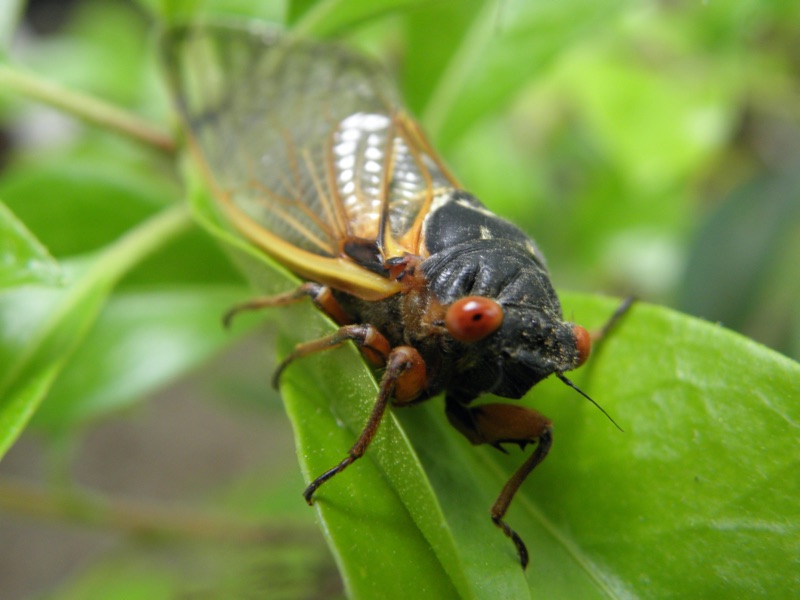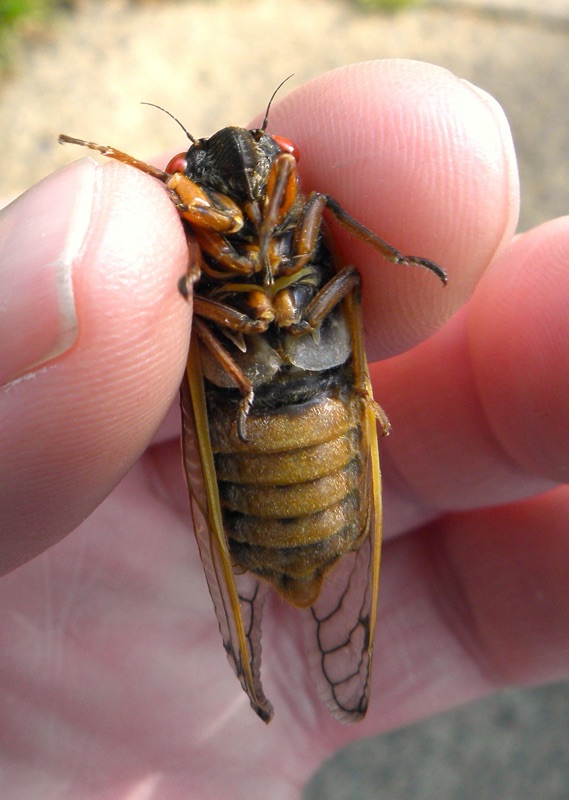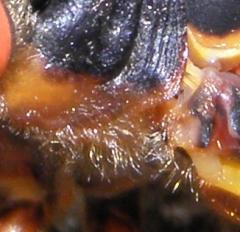Magicicada septendecim (Linnaeus, 1758) aka Linnaeus’s 17-Year Cicada aka Decim Periodical Cicada aka Pharaoh Cicada.

Photo credit: by Dan Mozgai. Brood II, NJ.

Photo credit: by Dan Mozgai. Brood II, NJ.
All Magicicada septendecim information and images on cicadamania.com.
Song type: Distress
Source: ©Cicada Mania | Species: M. septendecim
Song type: Court II
Source: ©Cicada Mania | Species: M. septendecim
Song type: Call
Source: ©Cicada Mania | Species: M. septendecim
Song type: Court III
Source: ©Cicada Mania | Species: M. septendecim
Song type: Court I
Source: ©Cicada Mania | Species: M. septendecim
Video
Video Playlist
Playlists contain multiple videos found on YouTube.
Identification Tips
M. septendecim is the largest of the 17-Year species. Its abdomen has thick orange stripes. It has orange coloring between its eye and wing. Its song sounds like “Wee-Oh”, “Pharaoh” and a group of them are said to sound like a “UFO from a science fiction movie”.
Color between the eye and wing insertion:

M. septendecim Brood Chart
Magicicada septendecim has a 17-year lifecycle.
| Brood | Years | States |
|---|---|---|
| I (1) | 1961, 1978, 1995, 2012, 2029 | TN, VA, WVA |
| II (2) | 1962, 1979, 1996, 2013, 2030 | CT, GA, MD, NC, NJ, NY, OK, PA, VA |
| III (3) | 1963, 1980, 1997, 2014, 2031 | IA, IL, MO |
| IV (4) | 1964, 1981, 1998, 2015, 2032 | IA, KS, MO, NE, OK, TX |
| V (5) | 1965, 1982, 1999, 2016, 2033 | LI NY, western MD, east OH, south-west PA, north-west VA, northern half of WV |
| VI (6) | 1949, 1966, 1983, 2000, 2017 | GA, NC, SC, WI, OH |
| VII (7) | 1950, 1967, 1984, 2001, 2018 | NY |
| VIII (8) | 1951, 1968, 1985, 2002, 2019 | OH, PA, WVA and OK |
| IX (9) | 1952, 1969, 1986, 2003, 2020 | NC, VA, WVA |
| X (10) | 1953, 1970, 1987, 2004, 2021 | DE, GA, IL, IN, KY, MD, MI, NC, NJ, NY, OH, PA, TN, VA, WVA, Washington DC |
| XIII (13) | 1956, 1973, 1990, 2007, 2024 | IA, IL, IN, MI, WI |
| XIV (14) | 1957, 1974, 1991, 2008, 2025 | GA, IN, KY, MA, MD, NC, NJ, NY, OH, PA, TN, VA, WVA |
Name, Location and Description
- Cicada Name: Magicicada septendecim (Linnaeus, 1758)
- Short Name: M. septendecim
- Common Name: Decim Periodical Cicada or Linnaeus’s 17-Year Cicada or 17-Year Cicada
- When: May-June. Peak in June. Every 17 years.
- Where it is found: CT, DC, DE, GA, IA, IL, IN, KS, KY, MA, MD, MI, MO, NC, NE, NJ, NY, OH, PA, RI, SC, TN, VA, WI, WV
- Maps: Map
- Description: Black body with orange wings and legs. Orange stripes on abdomen. Orange between eye and wing.
- Eye Color: reddish orange
- Pronotal Collar Color: black
- Identification: Bug Guide
- Identification: Bill Reynolds on iNaturalist
- Subject Matter Expert website: Cicadas @ UCONN (formerly Magicicada.org)
- Image: Insect Images
- Taxonomic Information: Integrated Taxonomic Information System
- Song: Cicadas @ UCONN (formerly Magicicada.org)
Classification:
Family: Cicadidae
Subfamily: Cicadettinae
Tribe: Lamotialnini
Subtribe: Tryellina
Genus: Magicicada
Species: Magicicada septendecim (Linnaeus, 1758)
List of sources
- Full Binomial Names: ITIS.gov
- Common names: BugGuide.net; The Songs of Insects by Lang Elliott and Wil Herschberger; personal memory.
- Locations: Cicadas @ UCONN (formerly Magicicada.org)
- Descriptions, Colors: personal observations from specimens or photos from many sources. Descriptions are not perfect, but may be helpful.
- Tribe information comes from: MARSHALL, DAVID C. et al.A molecular phylogeny of the cicadas (Hemiptera: Cicadidae) with a review of tribe and subfamily classification.Zootaxa, [S.l.], v. 4424, n. 1, p. 1—64, may 2018. ISSN 1175-5334. Available at: https://www.biotaxa.org/Zootaxa/article/view/zootaxa.4424.1.1
Notes:
- Some descriptions are based on aged specimens which have lost some or a lot of their color.

I live in southwestern Ohio, where brood X is currently emerging. I am wondering which species of periodical cicada is most abundant among Brood X, if any species specifically. And if it also depends on where you are on the brood’s range, which species is most abundant in SW Ohio/the Cincinnati area? Again, if any species specifically.
Most will be Magicicada septendecim (Linnaeus, 1758) aka Linnaeus’s 17-Year Cicada, but there’s plenty Magicicada cassinii (Fisher, 1852) aka Cassini 17-Year Cicada, and a bit less Magicicada septendecula Alexander and Moore, 1962.
Very cool! Started researching this due to a conversation about childhood summer memories… I have to admit I’m extremely impressed with this species and the amount of information I never knew! I’m officially a fan now, and looking forward to Brood X’s arrival next year!
Thank you!